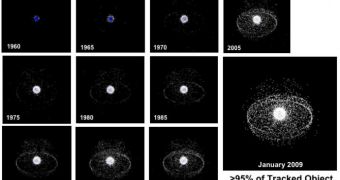Since the 1960s, the amount of debris in Earth's orbit has increased linearly, NASA experts have recently said. The danger of collision between sensitive spacecraft sent to orbit, including high-tech satellites, space shuttles, and the International Space Station (ISS), has since prompted drastic modifications in the amount of junk each space flight leaves behind, but close monitoring of the debris orbiting the planet has revealed no change in the growth patterns. However, in the past two years, a Chinese anti-satellite firing test and the collision of two satellites in orbit have drastically increased the number of debris.
The space junk, which can be about anything from chips of paint to screws, bolts, and pieces of solar panels, are traveling at speeds exceeding thousands of miles per hour, and have the ability to easily penetrate even the thickest armor of, for example, a tank back on Earth. Needless to say, delicate spacecraft are not armored when they are sent to orbit, so the only way for shuttle or capsule crews and for billion-dollar satellites to avoid getting smashed to pieces is to move out of harm's way.
In order for experts to be able to do this, they have to closely monitor the debris situation, using devices so sophisticated that they can detect pieces of junk smaller than four inches in size. However, there are tens of thousands of such pieces of debris, and launching a satellite in an already crowded orbit is a very tricky business. Another collision in space would exponentially raise the amount of junk, in what astronomers have called a “nuclear fission-type effect”, Wired reports.
“On average, Shuttle and ISS have conducted several collision avoidance maneuvers over the past ten years on the order of about one per year,” NASA’s Orbital Debris Program Office chief scientist Nicholas Johnson recently told reporters. In 2008, shuttles had to take evasive actions to avoid getting hit by junk four times, while the ISS moved out of harm's way at least one time, with an additional two maneuvers in 2009. The latest such threat occurred when the Discovery space shuttle was docked on the international facility and astronauts had to move both spacecraft at the same time.
The US is currently considering a number of options in its fight against space debris, including passive defense networks, as well as proactive approaches. It's still unclear which course of action they will take, but a proposal that seems to have a lot of supporters is the one regarding the Space Fence project, an array of orbit-based sensors that could analyze even smaller objects than existing, Earth-based arrays can do now.

 14 DAY TRIAL //
14 DAY TRIAL //